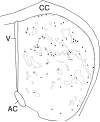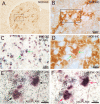In situ hybridization histochemical and immunohistochemical evidence that striatal projection neurons co-containing substance P and enkephalin are overrepresented in the striosomal compartment of striatum in rats
- PMID: 17868995
- PMCID: PMC2034403
- DOI: 10.1016/j.neulet.2007.08.033
In situ hybridization histochemical and immunohistochemical evidence that striatal projection neurons co-containing substance P and enkephalin are overrepresented in the striosomal compartment of striatum in rats
Abstract
In a prior study, we showed that the few striatal projection neurons that contain both substance P (SP) and enkephalin (ENK) in rats may preferentially project to the substantia nigra pars compacta. Since striatal neurons that project to the pars compacta are thought to preferentially reside in the striosomal compartment, we investigated if striatal neurons that contain both SP and ENK are preferentially localized to the patch compartment. We used in situ hybridization histochemistry to double-label sections for SP and ENK to identify SP/ENK co-containing neurons, and immunolabeling of adjacent sections for the mu opiate receptor (MOR) to define the striosomal compartment. We found that 32.3% of neurons containing both SP and ENK were localized to the striosomal compartment, which itself only made up 12.8% of the striatum. Our results further showed that the density of neurons co-containing SP and ENK was three-fold higher in striosomes than in the matrix compartment. These results are consistent with the notion that SP/ENK colocalizing neurons preferentially project to pars compacta, and these and our prior results additionally raise the possibility that neurons of this type in the striatal matrix may also project to the pars compacta.
Figures


Similar articles
-
Single-cell RT-PCR, in situ hybridization histochemical, and immunohistochemical studies of substance P and enkephalin co-occurrence in striatal projection neurons in rats.J Chem Neuroanat. 2006 Apr;31(3):178-99. doi: 10.1016/j.jchemneu.2006.01.003. Epub 2006 Feb 28. J Chem Neuroanat. 2006. PMID: 16513318
-
Enkephalinergic striatal projection neurons become less affected by quinolinic acid than substance P-containing striatal projection neurons as rats age.Exp Neurol. 2003 Dec;184(2):1034-42. doi: 10.1016/j.expneurol.2003.08.016. Exp Neurol. 2003. PMID: 14769398
-
Region-specific diversity of striosomes in the mouse striatum revealed by the differential immunoreactivities for mu-opioid receptor, substance P, and enkephalin.Neuroscience. 2013 Jun 25;241:215-28. doi: 10.1016/j.neuroscience.2013.03.012. Epub 2013 Mar 19. Neuroscience. 2013. PMID: 23518224
-
Extensive co-occurrence of substance P and dynorphin in striatal projection neurons: an evolutionarily conserved feature of basal ganglia organization.J Comp Neurol. 1990 May 15;295(3):339-69. doi: 10.1002/cne.902950302. J Comp Neurol. 1990. PMID: 1693632
-
Substance P and substance P receptor histochemistry in human neurodegenerative diseases.Regul Pept. 1993 Jul 2;46(1-2):174-85. doi: 10.1016/0167-0115(93)90028-7. Regul Pept. 1993. PMID: 7692486 Review.
Cited by
-
Differential loss of thalamostriatal and corticostriatal input to striatal projection neuron types prior to overt motor symptoms in the Q140 knock-in mouse model of Huntington's disease.Front Syst Neurosci. 2014 Oct 15;8:198. doi: 10.3389/fnsys.2014.00198. eCollection 2014. Front Syst Neurosci. 2014. PMID: 25360089 Free PMC article.
-
Rapid reversal of chondroitin sulfate proteoglycan associated staining in subcompartments of mouse neostriatum during the emergence of behaviour.PLoS One. 2008 Aug 20;3(8):e3020. doi: 10.1371/journal.pone.0003020. PLoS One. 2008. PMID: 18714376 Free PMC article.
-
Differential organization of cortical inputs to striatal projection neurons of the matrix compartment in rats.Front Syst Neurosci. 2015 Apr 14;9:51. doi: 10.3389/fnsys.2015.00051. eCollection 2015. Front Syst Neurosci. 2015. PMID: 25926776 Free PMC article.
-
Nr4a1-eGFP is a marker of striosome-matrix architecture, development and activity in the extended striatum.PLoS One. 2011 Jan 28;6(1):e16619. doi: 10.1371/journal.pone.0016619. PLoS One. 2011. PMID: 21305052 Free PMC article.
-
The dopamine d1-d2 receptor heteromer in striatal medium spiny neurons: evidence for a third distinct neuronal pathway in Basal Ganglia.Front Neuroanat. 2011 May 31;5:31. doi: 10.3389/fnana.2011.00031. eCollection 2011. Front Neuroanat. 2011. PMID: 21747759 Free PMC article.
References
-
- Albin RL, Young AB, Penney JB. The functional anatomy of basal ganglia disorders. Trends Neurosci. 1989;12:366–375. - PubMed
-
- Anderson KD, Reiner A. The extensive co-occurrence of substance P and dynorphin in striatal projection neurons: An evolutionarily conserved feature of basal ganglia organization. J. Comp. Neurol. 1990;295:339–369. - PubMed
-
- Augood SJ, Westmore K, Emson PC. Phenotypic characterization of messenger mRNA-expressing cells in the neuroleptic-treated rat striatum: a detailed cellular co-expression study. Neuroscience. 1997;76:763–774. - PubMed
-
- Beckstead RM, Cruz CJ. Striatal axons to the globus pallidus, entopeduncular nucleus and substantia nigra come mainly from separate cell populations in cat. Neuroscience. 1986;19:147–158. - PubMed
-
- Besson MJ, Graybiel AM, Quinn B. Coexpression of neuropeptides in the cat's striatum: An immunohistochemical study of substance P, dynorphin B and enkephalin. Neuroscience. 1990;39:33–58. - PubMed
Publication types
MeSH terms
Substances
Grants and funding
LinkOut - more resources
Full Text Sources
Research Materials
Miscellaneous

